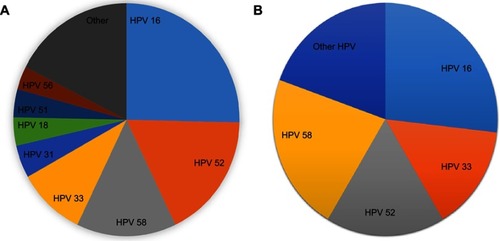Figures & data
Table 1 Specifications of oligonucleotides used as primers and probes for HPV detection by PCR
Figure 1 (A) HPV genotypes identified in exfoliated cervical cells via the flow fluorescence in situ hybridization technique. (B) HPV genotypes identified in surgical smoke via the flow fluorescence in situ hybridization technique.

Table 2 HPV infections detected by flow fluorescence in situ hybridization and a conventional PCR assay in exfoliated cervical cells and surgical smoke. A PCR assay was used to detect the six most common HPV genotypes in exfoliated cervical cells
Table 3 Concordance and agreement for HPV detection by using flow fluorescence in situ hybridization and a PCR assay in exfoliated cervical cells. A PCR assay was used to detect the six most common HPV genotypes in exfoliated cervical cells
Table 4 Detection of specific HPV genotypes by flow fluorescence in situ hybridization in exfoliated cervical cells, surgical plume and LEEP operators’ nasal swab samples
Table 5 Correlation of HPV DNA in surgical smoke with the distance of the suction device from the surgical site, operation time and pathological grade
Table S1 The association between HPV DNA in exfoliated cervical cells and surgical smoke
Table S2 Multivariate analysis of the correlation of HPV infection in surgical smoke with the location of the surgical smoke collection from the top of suction device
